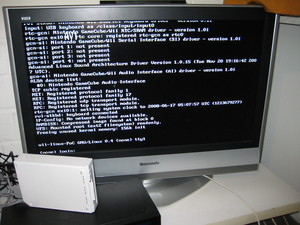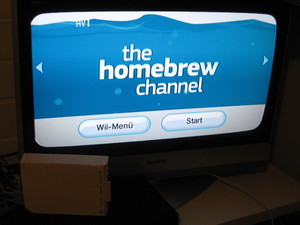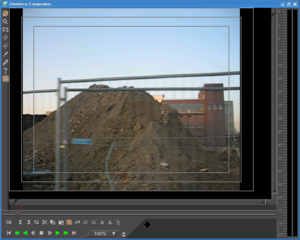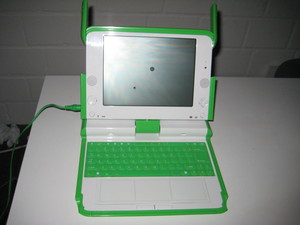Monday, June 30. 2008
OpenStreetMap in der BNN
Die BNN (Badische Neueste Nachrichten, Lokalzeitung aus Karlsruhe) interviewte mich vergangene Woche zum OpenStreetMap-Projekt.
Der Artikel ist meiner Ansicht nach recht gelungen, einzig hat sich ein Fehler eingeschlichen: Ich bin erst seit etwas mehr als einem Jahr (im Artikel wurden drei Jahre angegeben) bei OpenStreetMap aktiv.
Freundlicherweise wurde mir gestattet, den Artikel online verfügbar zu machen:
»Bald sind wir besser als jede andere Landkarte« (BNN vom 28./29. Juni 2008)
Der Artikel ist meiner Ansicht nach recht gelungen, einzig hat sich ein Fehler eingeschlichen: Ich bin erst seit etwas mehr als einem Jahr (im Artikel wurden drei Jahre angegeben) bei OpenStreetMap aktiv.
Freundlicherweise wurde mir gestattet, den Artikel online verfügbar zu machen:
»Bald sind wir besser als jede andere Landkarte« (BNN vom 28./29. Juni 2008)
Tuesday, June 17. 2008
Linux on a Wii
 Today I played around a bit with the stuff done by the Wii homebrew/hacking community, which is far more advanced than I had expected.
Today I played around a bit with the stuff done by the Wii homebrew/hacking community, which is far more advanced than I had expected.I had the game Twilight Princess borrowed by a friend. For those who don't know, using this game you can run homebrew software on the Wii without the need of a modchip.
 The way this works is that first you install a modified savegame for Twilight Princess, afterwards you can install the Homebrew Channel. The Homebrew Channel will stay in the main Wii Menu and you'll be able to run various stuff from there. While looking around the various webpages covering the topic, I found that wiibrew.org is a good place to find documentation and links to the appropriate projects. So look there for the details.
The way this works is that first you install a modified savegame for Twilight Princess, afterwards you can install the Homebrew Channel. The Homebrew Channel will stay in the main Wii Menu and you'll be able to run various stuff from there. While looking around the various webpages covering the topic, I found that wiibrew.org is a good place to find documentation and links to the appropriate projects. So look there for the details.The gc-linux project (originally porting linux to the gamecube) has a simple Linux image available.
A warning: Nintendo released a new firmware that stops this method to work, so if you wanna have fun, don't update your Wii. And the obvious warning: Everything you do is at your own risk.
Update: Seems the Firmware update is no longer a problem.
Posted by Hanno Böck
in Code, Computer culture, English, Gentoo, Linux
at
23:52
| Comments (3)
| Trackback (1)
Monday, June 16. 2008
Videobericht von der Demonstration gegen Kohlekraftwerk Mannheim
Ist zwar schon ein Weilchen her, aber ich hab auf der Demonstration gegen das Kohlekraftwerk Mannheim am 24. Mai ein paar Videos gemacht, die ich nun zu einem kleinen Bericht zusammengeschnitten habe.
Das Video ist natürlich genauso frei wie der Inhalt dieses Blogs, Rohmaterial auf Anfrage bei mir. Es stellt gleichzeitig meine ersten Gehversuche mit Cinelerra dar.
Download als OGG Vorbis/Theora
Video auf Youtube
Das Video ist natürlich genauso frei wie der Inhalt dieses Blogs, Rohmaterial auf Anfrage bei mir. Es stellt gleichzeitig meine ersten Gehversuche mit Cinelerra dar.
Download als OGG Vorbis/Theora
Video auf Youtube
Posted by Hanno Böck
in Ecology, Movies, Politics
at
00:18
| Comment (1)
| Trackbacks (0)
Defined tags for this entry: cinelerra, gkm, klima, klimawandel, kohle, kohlekraftwerk, mannheim, ökologie, video
Thursday, June 12. 2008
0.01 % of Xorg
Phoronix has just published an article about the development of xorg and they have a statistics of contributors from Distributions.
I'm listed there on the Gentoo part with 0.01 % contributions to Xorg. Yay!
I'm listed there on the Gentoo part with 0.01 % contributions to Xorg. Yay!
Tuesday, June 10. 2008
OpenStreetMap on RTL
 Today we met a team from the german television station RTL.
Today we met a team from the german television station RTL.They made some recordings in Bad Cannstatt and in a forest near Murrhardt. It will probably come in the »Nachtjournal«, we don't know a date yet. Hopefully the recording will be available online as well.
Update: You can now download Nachtjournal from 3th July.
Posted by Hanno Böck
in Computer culture, Copyright, English, Life
at
20:28
| Comments (4)
| Trackbacks (0)
Wednesday, June 4. 2008
Rapid Prototyping, 3D-Drucker, RepRap
Zum Thema Rapid Prototyping und dessen möglicherweise gravierenden gesellschaftlichen Auswirkungen las ich das erste mal in einen Text der Zukunftswerkstatt Jena, der im sehr lesenswerten Büchlein »Herrschaftsfrei Wirtschaften« veröffentlicht wurde (welches es auch komplett zum Download gibt).
Aber der Reihe nach: In der Debatte um freie Software, speziell in eher politisierten Kreisen (Stichworte sind hier etwa Ökonux oder das Keimform-Blog), wird des öfteren die Frage aufgeworfen, ob die Art und Weise, wie freie Software produziert wird, nicht als Modell für gesellschaftliches Wirtschaften insgesamt herhalten kann. Dabei wird oft der Begriff »Keimform« aus der Wertkritik gebraucht, der etwas bezeichnet, was zwar im bestehenden Kapitalismus und dessen Kontext stattfindet, aber erste Züge anderer Strukturen aufweist.
Nun stellt sich naiverweise erstmal die Herausforderung, dass immaterielle Güter (Software, Musik, Text) mit vernachlässigbarem Aufwand kopiert werden können, insofern die Adaption der Prinzipien freier Software hier nahe liegt (bestes Beispiel die Wikipedia), im Gegensatz dazu natürlich materielle Güter hier herausfallen, weil sie immer noch einen vergleichsweise großen Produktionsaufwand pro Stück besitzen.
Die Science-Fiction-lastig anmutende Frage »Lässt sich das ändern?« bringt uns nun zurück zum Thema Rapid Prototyping. Damit werden Verfahren bezeichnet, komplett automatisiert Gegenstände zu erschaffen, im einfachsten Beispiel etwa die (schon länger technisch machbaren) 3D-Drucker, die Kunststoffgebilde nach Computervorbild erschaffen können. Weiter gedacht könnten derartige Gerätschaften, wenn sie mit unterschiedlichen Materialien arbeiten, auch zur Produktion komplexerer Geräte genutzt werden.
Das Ziel, was sich vor einigen Jahren der Wissenschaftler Adrian Bowyer setzte, lautet nun: Eine Maschine, welche in der Lage ist, sich selbst neu zu erschaffen. Sozusagen vergleichbar mit dem Schritt, als der erste Compiler lernte, sich selbst zu übersetzen.
Heute vermeldet Golem, dass es erstmals gelungen ist, einen sogenannten RepRap dazu zu bringen, sich selbst zu reproduzieren. Von der Gesellschaft freier Güter mögen wir sicher noch ein Stück entfernt sein, sollte der RepRap allerdings tatsächlich das leisten, was seine Erfinder vermeldeten, sind wir ihr möglicherweise ein gutes Stück näher.
Achja: Der RepRap steht mit der GPL selbstverständlich unter einer freien Lizenz.
Aber der Reihe nach: In der Debatte um freie Software, speziell in eher politisierten Kreisen (Stichworte sind hier etwa Ökonux oder das Keimform-Blog), wird des öfteren die Frage aufgeworfen, ob die Art und Weise, wie freie Software produziert wird, nicht als Modell für gesellschaftliches Wirtschaften insgesamt herhalten kann. Dabei wird oft der Begriff »Keimform« aus der Wertkritik gebraucht, der etwas bezeichnet, was zwar im bestehenden Kapitalismus und dessen Kontext stattfindet, aber erste Züge anderer Strukturen aufweist.
Nun stellt sich naiverweise erstmal die Herausforderung, dass immaterielle Güter (Software, Musik, Text) mit vernachlässigbarem Aufwand kopiert werden können, insofern die Adaption der Prinzipien freier Software hier nahe liegt (bestes Beispiel die Wikipedia), im Gegensatz dazu natürlich materielle Güter hier herausfallen, weil sie immer noch einen vergleichsweise großen Produktionsaufwand pro Stück besitzen.
Die Science-Fiction-lastig anmutende Frage »Lässt sich das ändern?« bringt uns nun zurück zum Thema Rapid Prototyping. Damit werden Verfahren bezeichnet, komplett automatisiert Gegenstände zu erschaffen, im einfachsten Beispiel etwa die (schon länger technisch machbaren) 3D-Drucker, die Kunststoffgebilde nach Computervorbild erschaffen können. Weiter gedacht könnten derartige Gerätschaften, wenn sie mit unterschiedlichen Materialien arbeiten, auch zur Produktion komplexerer Geräte genutzt werden.
Das Ziel, was sich vor einigen Jahren der Wissenschaftler Adrian Bowyer setzte, lautet nun: Eine Maschine, welche in der Lage ist, sich selbst neu zu erschaffen. Sozusagen vergleichbar mit dem Schritt, als der erste Compiler lernte, sich selbst zu übersetzen.
Heute vermeldet Golem, dass es erstmals gelungen ist, einen sogenannten RepRap dazu zu bringen, sich selbst zu reproduzieren. Von der Gesellschaft freier Güter mögen wir sicher noch ein Stück entfernt sein, sollte der RepRap allerdings tatsächlich das leisten, was seine Erfinder vermeldeten, sind wir ihr möglicherweise ein gutes Stück näher.
Achja: Der RepRap steht mit der GPL selbstverständlich unter einer freien Lizenz.
Posted by Hanno Böck
in Computer culture, Linux, Politics, Science
at
23:05
| Comments (0)
| Trackback (1)
Defined tags for this entry: 3ddrucker, freesoftware, freiegesellschaft, rapidprototyping, reprap, sciencefiction, society
Tuesday, June 3. 2008
Yippie
Video editing with Cinelerra
 Sometimes in the past I had the wish to produce some simple videos, e. g. from political actions. Though I was looking for some free software solutions for video editing.
Sometimes in the past I had the wish to produce some simple videos, e. g. from political actions. Though I was looking for some free software solutions for video editing.I asked around but it seemed that most people didn't use free solutions. I never did any video editing before, so I had no comparison on what proprietary tools are able to do. My requirements where not that advanced, basically I wanted to be able to cut some videos together, fade them in and out, add some text over them. Beside, I wanted to be able to display images for some seconds.
I knew of three free video editing tools for linux, Kino, PiTiVi and Cinelerra. Kino and PiTiVi are quite simple to use, they have an intuitive interface. But I soon came to the conclusion that they are far too limited in features. So Cinelerra is left.
Cinelerra is not a simple tool, it's interface is not intuitive. So this was keeping me away from using it for a long time. But the good news is, Cinelerra has all the features I wanted and can do much more. As I said above, I don't have any experience with commercial tools, but I think Cinelerra can do pretty much everything one will need when doing professional video editing.
To learn how to use Cinelerra, there are some great video tutorials at the_source. It's a (CC-by licensed) video show about free software and video stuff and they did four Cinelerra tutorials in their show. You should at least watch the first three and try the stuff out between the tutorials, but that will give you the basic knowledge to get started with Cinelerra.
So, the first Cinelerra-produced video by me should be available here within the next days.
Beside, I just bumped the Cinelerra package in Gentoo, so emerge it and have fun.
Posted by Hanno Böck
in Computer culture, Gentoo, Linux, Movies
at
15:15
| Comments (2)
| Trackbacks (0)
(Page 1 of 1, totaling 8 entries)
